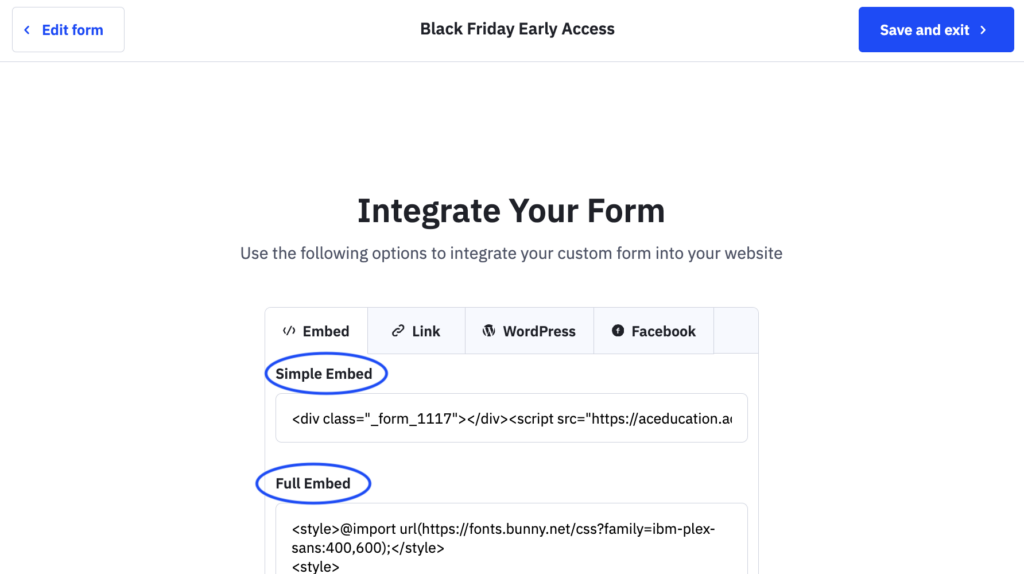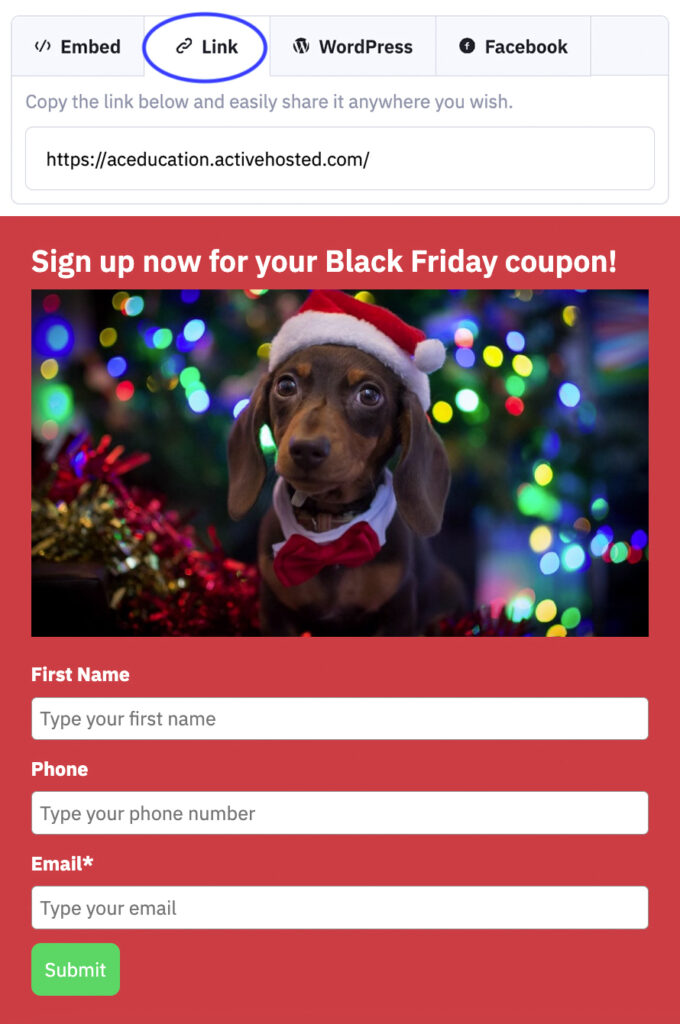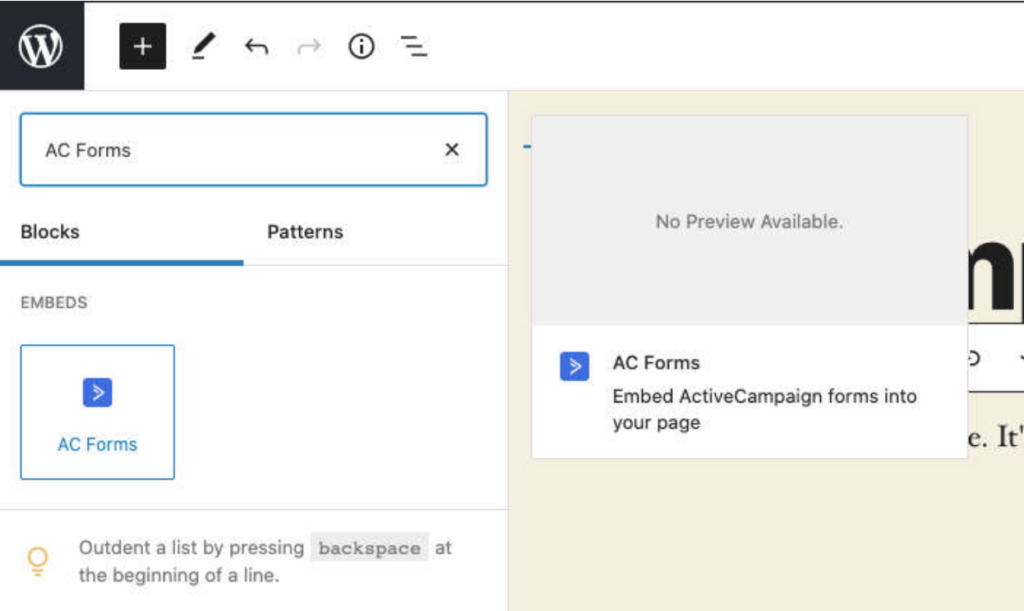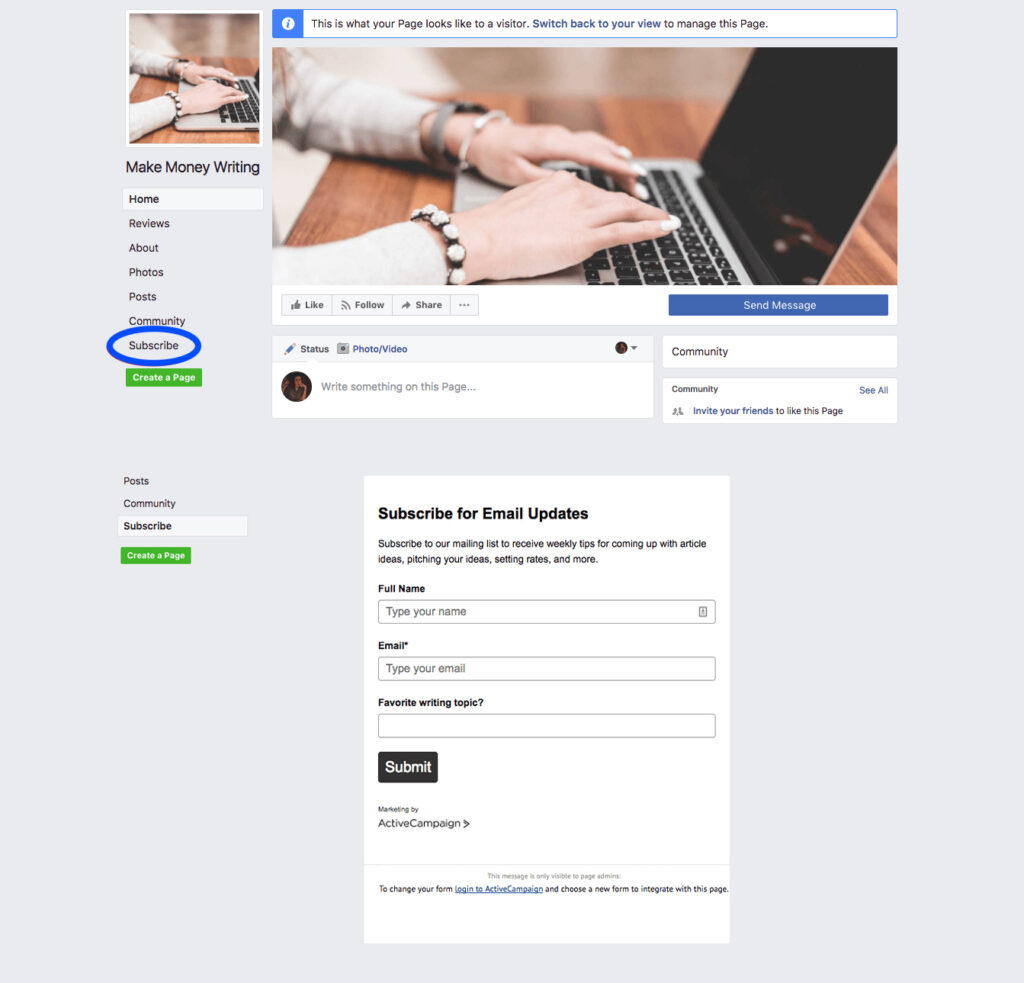Introduction
Your ActiveCampaign account offers four ways for you to create forms to capture your audience’s information.
From inline forms that blend seamlessly with your content to modal forms that capture attention while they are browsing your website, each type offers unique advantages in connecting with your audience.
In just a few clicks, these forms can be shared across various platforms, making them a versatile tool in your digital marketing arsenal.
This guide will explain the process of integrating your form with your website and all of your integration options.
Four methods of sharing your ActiveCampaign forms
Once you create a form, the next step is to share it with your audience to gather lead info or capture additional information about your existing contacts.
Your ActiveCampaign account provides you with four methods of sharing your form, namely an embed code, direct link, WordPress plugin and Facebook integration. In this section, we will go over each one and provide insight on how to strategically use each one to drive form engagement based on your needs and goals.
Embedding a Form
This is the most direct way to integrate a form into your website and it ensures a seamless user experience, keeping visitors engaged on your site without redirections.
There are two types of embed, a Simple Embed and a Full Embed option. We will review them in detail later in this guide.

For example, a retail website embeds an inline form at the end of blog posts to capture email sign-ups, maintaining the flow of the user’s journey. A reader just derived value from reading the blog and is more likely to sign up for more valuable content. Once they sign up, you can enter them into a nurture automation to eventually convert them into happy customers.
Check out this automation recipe and simply ensure that you set up an action to add contacts to the appropriate list upon form submission. This is available on all form types, but only in-line forms have the full embed option.
Sharing a link
The simplest way to share a form created in your ActiveCampaign account is with a link.
Sharing a link to your form can be effective, especially in email campaigns or social media posts where a direct call to action is needed. By using the robust design tools available on the form builder you can create a great on-brand experience.
An e-commerce brand can strategically use this method of sharing a form via a link in their bio across their social channels, inviting followers to sign up for upcoming black friday deals.
This is only available on in-line forms.

WordPress plugin
Although you can embed a form or simply share a link to your form on your WordPress website, the dedicated WordPress plugin is the optimal way to create a great form experience on your site. This plugin simplifies the process of adding a form to your site and ensures that it is in line with your website’s design and user experience.
This is available on all form types.

For example, a travel blogger can embed a form on the sidebar of their blog, encouraging readers to subscribe as they scroll and read various blog posts. The plugin allows quick adjustments and updates so that your forms are always aligned with your changing content strategies, design or any seasonal deals without the need for a dedicated developer.
Facebook Page Tab
According to SproutSocial, the amount of time internet users spend on social media is now higher than ever — 151 minutes per day. By adding your ActiveCampaign forms to your Facebook page, you’re expanding the reach of your forms beyond your website and email campaigns increasing lead generation. This is available only on in-line forms.

For example, a local bakery could add a newsletter subscription form as a tab on its Facebook page, making it easy for followers to sign up while browsing their latest posts and updates. This approach not only broadens the reach of your form but also capitalizes on the high engagement levels typically seen on social platforms such as Facebook.
Once set up, visitors to your Facebook page can fill out the form without leaving the site, giving them a seamless experience. Go beyond the form integration and learn about Facebook’s other powerful tools that can integrate with your ActiveCampaign account.
Embedding ActiveCampaign forms on your website
When copying and pasting your code, you can use either the simple embed code or the full embed code:
- Simple Embed – Any changes you make to your form from the platform will be immediately reflected on your website. This simple embed code is available for all four form styles: inline, floating bar, floating box, and modal.
- Full Embed – You can think of it as a static form—any changes you make to your form from the platform will not be reflected on your website. Instead, you’ll need to re-paste your form code in order to see your updates or make changes directly into your pasted form code. The full embed code is available for inline forms only.
Each option has its benefits and drawbacks: one offers a convenient plug-and-play solution that syncs automatically with changes in your ActiveCampaign account, while the other requires extra developer effort but allows for more customization.
Keeping in mind that the modal, floating bar and floating box style of forms can only live on a website and are not standalone forms and in-line forms can be embedded on your website with a certain level of customization, let’s review both options in detail.
When you opt for the Simple Embed method, you’re choosing efficiency and effectiveness. You can easily insert a form onto your site with just a few clicks. For a local business with minimal resources that needs a form to inform customers of new bakery items and seasonal flavors, the simple embed is the way to go.
The owner can create and add the form to their site in under 10 minutes. If the form has a small typo, the owner can simply update the form on their ActiveCampaign account and it will automatically publish to the site. This is how the simple embed option offers a hassle-free way for visitors to reach out, thus enhancing the business’s approachability and lead interaction.
On the other hand, the Full Embed option opens the door to more customization. It is best for business owners with access to a developer and the need for additional customization. For example, a large national retail chain might utilize this type of embed for their forms to match their store’s aesthetic, adjusting everything from the font styles to their color palette.
This level of customization not only improves visual appeal but also reinforces brand consistency throughout the customer’s browsing experience. However, the full embed option for forms does not update the public-facing form automatically when changes are made to the form on your ActiveCampaign account. An experienced developer is required to set up and configure the form for you on your site.
Both embedding methods, Simple and Full, come with their own sets of advantages, catering to diverse needs and technical proficiencies.
Whether you prioritize ease of use or are looking for a more tailored look to resonate with your brand identity, ActiveCampaign provides the tools to seamlessly integrate these forms into your overall marketing and sales strategy. In doing so, you create a cohesive and interactive user experience, encouraging visitors to engage, connect, and convert, directly from your website!
Creating a tailored experience with form links
If your business does not need or have a website, our form links are the best way for you to collect data from your leads and contacts. This method is only available for forms you create in the in-line style on your ActiveCampaign account.
During the design phase, you can modify its appearance extensively to align with specific campaign themes or your website’s layout. This flexibility ensures that whether the form is shared via an email campaign, social media, or as a call-to-action on a blog post, it always leads to a form that’s visually in line with your brand’s style.
Another strategic feature of linking to a form is the ability to set up URL redirect to upon form submission. After a visitor submits the form, they can be directed to a personalized landing page such as a thank you message, a detailed product page, or a special offer.
For example, a marketing consultancy firm might redirect users to a page detailing their consultation process post-inquiry submission, thereby keeping their leads engaged and informed. This not only enhances the user experience but also paves the way for deeper engagement, turning a simple form submission into a continuous, engaging journey for the visitor.
Next Steps and Implementation
We hope you now understand how to elevate your digital engagement with ActiveCampaign forms by using the appropriate type of form and the relevant sharing method for your lead gen or general contact data collection.
Learn more about choosing the right form type for your business needs and creating one from scratch here.
If you need additional help, our customer experience team is always available to help here.



